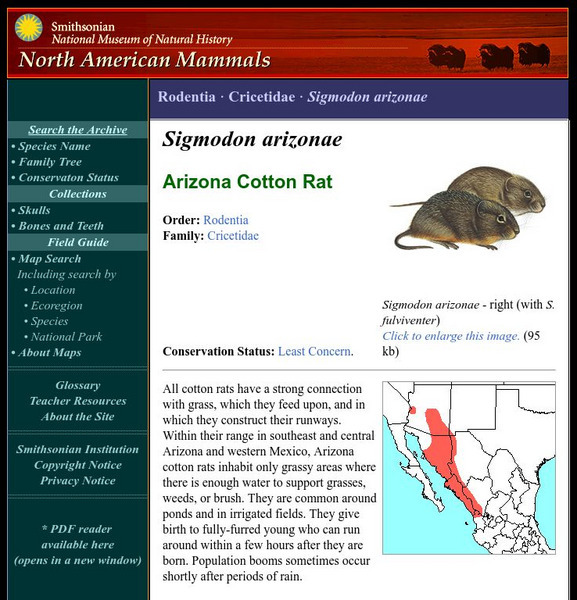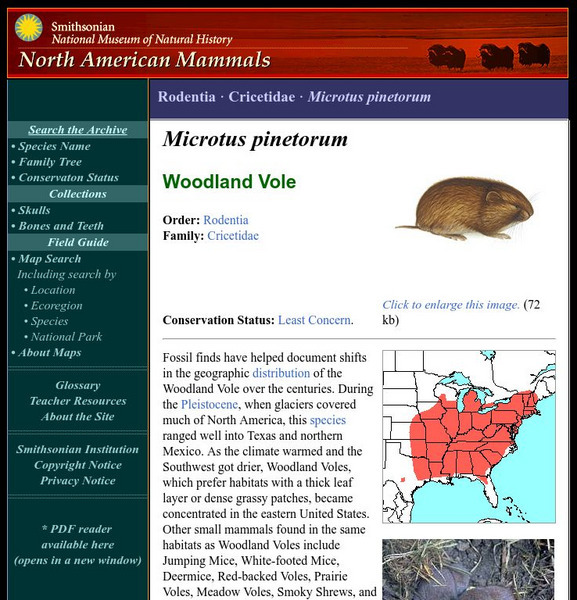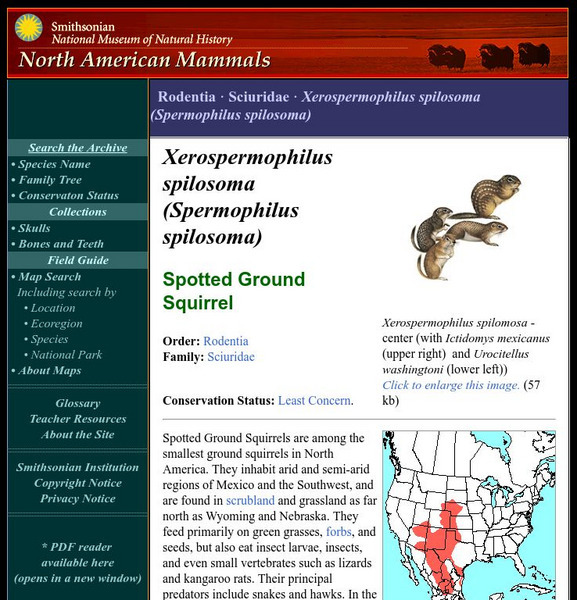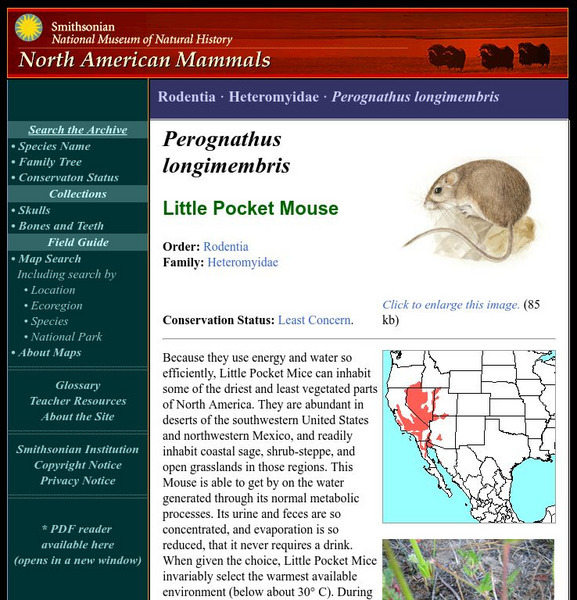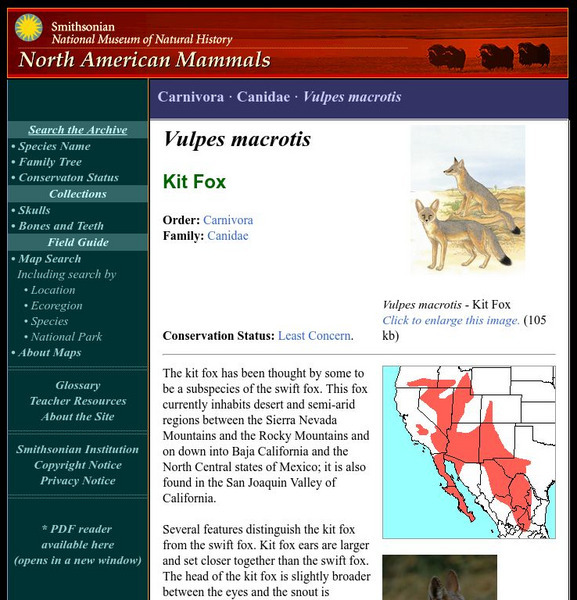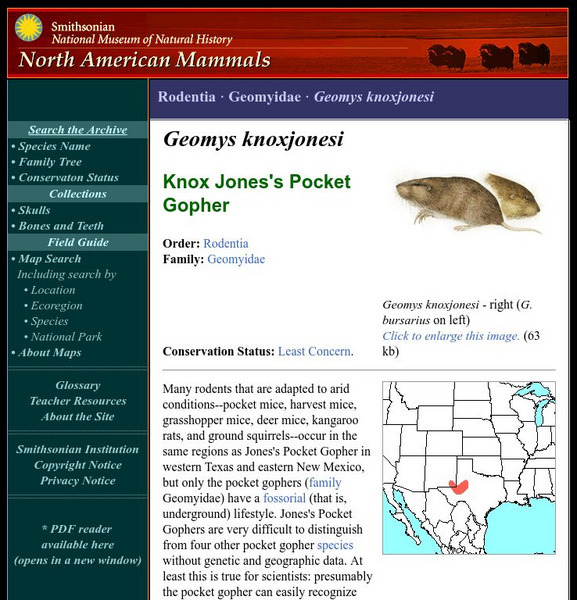Smithsonian Institution
National Museum of Natural History: American Mammals: White Ankled Mouse
The White-ankled Mouse is common in rocky areas in both dry and humid regions on the Central Plateau of Mexico and in west and central Texas, southern New Mexico, and Oklahoma. It clearly prefers rocky situations, whether it lives in...
Smithsonian Institution
National Museum of Natural History: American Mammals: Northern Rock Deermouse
Northern Rock Deermice live in rocky outcrops and among boulders in pinyon-juniper-oak woodlands in the foothills of mountains from Colorado and New Mexico south to Texas and northern Mexico. Populations of the Mice are separated from...
Smithsonian Institution
National Museum of Natural History: American Mammals: Osgood's Mouse
Osgood's Mouse is a very close relative of the Pinyon Mouse but is larger, and its tail is longer than the head and body. Osgood's Mouse lives in the mountains of southern New Mexico and throughout mountainous central Mexico. Learn more...
Smithsonian Institution
National Museum of Natural History: American Mammals: Nelson's Pocket Mouse
Nelson's Pocket Mice live in the Chihuahuan Desert of north-central Mexico and adjacent parts of western Texas and southern New Mexico. They are found mostly in rocky areas where there are some shrubs to provide cover. Learn more about...
Smithsonian Institution
National Museum of Natural History: American Mammals: Preble's Shrew
Very little is known about the natural history of Preble's Shrew, which has been found in widely separate localities in much of the western United States. Specimens have been collected at elevations of 1,280 m in Oregon and 2,750 m in...
Smithsonian Institution
National Museum of Natural History: American Mammals: Arizona Cotton Rat
All cotton rats have a strong connection with grass, which they feed upon, and in which they construct their runways. Within their range in southeast and central Arizona and western Mexico, Arizona cotton rats inhabit only grassy areas...
Smithsonian Institution
National Museum of Natural History: American Mammals: Brazilian Free Tailed Bat
Millions of Brazilian free-tailed bats spend their summers in the southwestern United States. Gigantic colonies summer in Bracken Cave, Texas; Carlsbad Caverns, New Mexico; and even within the city of Austin, Texas, under the Congress...
Smithsonian Institution
National Museum of Natural History: American Mammals: Western Small Footed Myotis
The western small-footed myotis occurs in limited areas of southwestern Canada, throughout much of the western United States, and into Mexico. It is better adapted to moist areas than to dry ones. Learn more about the Myotis ciliolabrum,...
Smithsonian Institution
National Museum of Natural History: American Mammals: Texas Pocket Gopher
Only soils with low percentages of silt, clay, and gravel will do for the Texas Pocket Gopher, so many of its populations are isolated from one another. The species occurs in southern Texas and extreme northeastern Mexico, burrowing in...
Smithsonian Institution
National Museum of Natural History: American Mammals: Eastern Red Bat
Common and widespread from far southern Canada throughout most of the United States and Mexico, and farther south through Central America and into South America, the Eastern Red Bat requires trees and shrubs for roosting. It is...
Smithsonian Institution
National Museum of Natural History: American Mammals: Mexican Long Nosed Bat
The Mexican long-nosed bat feeds mainly on the nectar and pollen of agaves, and is found in Texas in June and July when the plants are in bloom there. Then it migrates southward into Mexico, where it lives in pine-oak forests and...
Smithsonian Institution
National Museum of Natural History: American Mammals: Plains Pocket Mouse
The color of the Plains Pocket Mouse varies with soil color. The black volcanic sands near Flagstaff, Arizona harbor mice with nearly black fur, and mice with nearly white fur match the white gypsum dunes of New Mexico. Learn more about...
Smithsonian Institution
National Museum of Natural History: American Mammals: Southwestern Myotis
Southwestern myotis live in a variety of southwestern mountain habitats, from desert grasslands up into pine and mixed coniferous forest in the United States, and in desert and grassland in Mexico. These bats and two other myotis...
Smithsonian Institution
National Museum of Natural History: American Mammals: Woodland Vole
Fossil finds have helped document shifts in the geographic distribution of the Woodland Vole over the centuries. During the Pleistocene, when glaciers covered much of North America, this species ranged well into Texas and northern...
Smithsonian Institution
National Museum of Natural History: American Mammals: Spotted Ground Squirrel
Spotted Ground Squirrels are among the smallest ground squirrels in North America. They inhabit arid and semi-arid regions of Mexico and the Southwest and are found in scrubland and grassland as far north as Wyoming and Nebraska. Learn...
Smithsonian Institution
National Museum of Natural History: American Mammals: San Diego Pocket Mouse
The San Diego Pocket Mouse occurs in desert and coastal habitats in southern California, Mexico, and northern Baja California, from sea level to at least 1,400 m. Yellowish or orange hair on its sides contrasts with a dark brown back,...
Smithsonian Institution
National Museum of Natural History: American Mammals: Little Pocket Mouse
Because they use energy and water so efficiently, Little Pocket Mice can inhabit some of the driest and least vegetated parts of North America. They are abundant in deserts of the southwestern United States and northwestern Mexico, and...
Smithsonian Institution
National Museum of Natural History: American Mammals: Kit Fox
The kit fox has been thought by some to be a subspecies of the swift fox. This fox currently inhabits desert and semi-arid regions between the Sierra Nevada Mountains and the Rocky Mountains and on down into Baja California and the North...
Smithsonian Institution
National Museum of Natural History: American Mammals: Gulf Coast Kangaroo Rat
Gulf Coast Kangaroo Rats are confined to barrier islands of northeastern Mexico and southern Texas and the nearby Texas mainland. No fossils of this species have been found, but because of features of its teeth and skull, scientists...
Smithsonian Institution
National Museum of Natural History: American Mammals: Jones's Pocket Gopher
Many rodents that are adapted to arid conditions--pocket mice, harvest mice, grasshopper mice, deer mice, kangaroo rats, and ground squirrels--occur in the same regions as Jones's Pocket Gopher in western Texas and eastern New Mexico,...
Smithsonian Institution
National Museum of Natural History: American Mammals: Southern Pocket Gopher
Because most Southern Pocket Gophers live at high elevations in the mountains of Mexico, they are less accessible, and have been less-studied, than some other species. Like all pocket gophers, they are vegetarians, consuming both...
Smithsonian Institution
National Museum of Natural History: American Mammals: Desert Pocket Mouse
The Desert Pocket Mouse is a common inhabitant of warm deserts throughout the United States and Mexico. It prefers sandy soil and avoids rocky settings, and like other pocket mice, comes out at night to search for seeds. Learn more about...
Smithsonian Institution
National Museum of Natural History: American Mammals: Western Red Bat
This close cousin to the eastern red bat (Lasiurus borealis) is genetically distinct. These bats are found along the west coast and the southwestern US and into Mexico where they are thought to hibernate in the winter. Learn more about...
Smithsonian Institution
National Museum of Natural History: American Mammals: Mexican Long Tongued Bat
Mexican long-tongued bats feed on fruits, pollen, nectar, and probably insects. The populations that summer in the United States migrate to Mexico and northern Central America in winter, following the blooming cycle of plants such as...





